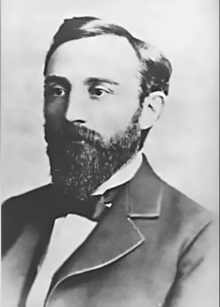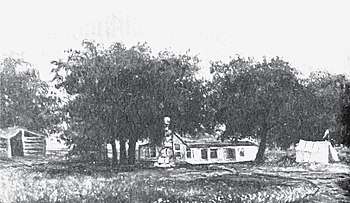Egbert Starr Newbury
Egbert Starr Newbury (September 8, 1843 – February 10, 1880) was the founder of Newbury Park, California,[1] and the first newspaper reporter in the Conejo Valley.[2] He was the first postmaster in the Conejo Valley, and established the Newbury Park Post Office in 1875. He was one of the three first to purchase Rancho El Conejo land in the Conejo Valley, and he may have built the valley's first cottage.[3]
Egbert Starr Newbury | |
|---|---|
 | |
| Born | September 8, 1843 |
| Died | February 10, 1880 (aged 36) |
| Spouse(s) | Frances “Fannie” Maria Kellogg Newbury
( m. 1873) |
| Children | 4 |
Born in Michigan, Newbury traveled to California due to health reasons in 1871. He bought 2,200 acres in the Conejo Valley in 1874, on land which stretched from today’s old town Thousand Oaks and into southern Newbury Park. He left Newbury Park after the drought of 1877, and ultimately moved back to Michigan where he resided in Detroit.
Besides the town of Newbury Park and its post office, Newbury Road is also named after E.S. Newbury.[4]
A replica of Newbury's home is located at the Tri-Village at the Stagecoach Inn museum in Newbury Park.[5]
Newbury was a Republican and a member of the Presbyterian Church.[6]
Early life
Egbert Starr Newbury was born on September 8, 1843 in Jackson, Michigan. Because of health reasons, he moved to Southern California in 1871 where he first settled in Santa Barbara. In 1872, he traveled to San Francisco to welcome his friend Fannie to California. They were old friends from Jackson, and Fannie had just also made the decision to relocate to California. Newbury brought Fannie to Santa Barbara in January 1873 and they later got engaged. They enjoyed horseback-riding on the beach and Newbury’s engagement present to Fannie was a horse she named Flora. They got married on July 9, 1873 in San Francisco. Their honeymoon was a one-week trip by boat, stagecoach and train to Santa Cruz, Pescadero and San Mateo. They sailed by the steamship Orazabo back to Santa Barbara.[7]
Newbury Park

Newbury was among the first to purchase former Rancho El Conejo land, when he bought 2,200 acres of land in the Conejo Valley in 1874.[9] He would often travel for days between the Conejo Valley and Santa Barbara while he built corrals for sheep and a wooden cottage. After Frances Kellogg Newbury gave birth to the first of his four children in May 1874, he decided it was time to relocate the family to his property in Conejo Valley. Here he planted acres of wheat, built a barn and later bought 1600 sheep from Winchester Ranch in Santa Barbara.[10] The Conejo Valley was remote and only five families lived here, on large ranch lands miles apart from one another. There were no grocery stores, medical facilities, schools, or churches in the valley[11]
He wrote to his sister back home in Michigan on November 23, 1874:
take wings and come to Conejo and enjoy our warm bright days all winter… be outdoors instead of confined indoors… I am out all the time and our drives now are just lovely with the country all turning green. The birds stay around our house in flocks all the time… Our roads to the ranch are splendid and they lie through beautiful canyons and large groves of live and white oak and sycamore, then into an open valley with slopes and surrounding hills covered with evergreen oaks...[12][13]
It was an increased interest in the Conejo Valley, and Newbury functioned as a public relations representative for Conejo Valley.[14] He was also the correspondent for two Ventura County newspapers, including Ventura Signal.[15] As the residents of the valley had to travel to San Buenaventura in order to get their mail, Newbury applied to Washington, DC for a new post office in town. He decided on the name Newbury Park, as the area looked like a lovely park community.[16][17] The Newbury Park Post Office was the first post office in Conejo Valley when it opened on July 16, 1875 with Egbert Starr Newbury as postmaster.[18]
In November 1876, Conejo Valley residents voted in the presidential election between Rutherford B. Hayes and Samuel J. Tilden. As Newbury’s ranch was also the location of the local post office, voters voted from the polling place at Newbury’s home.[19]
An unforeseen drought took place between 1876-1878, in which there were only six inches of rain in 30 months. Crops died due to no rain, and ultimately the ranchers’ sheep died due to the lack of food. Newbury went bankrupt and was forced to sell his land at a sheriff's sale. He ultimately left with his family in 1877, and rode home to Michigan, where he settled in Detroit. There he worked as a shoe salesmen trying to pay down debt collected in California.[19][20]
The harsh climate had a bad impact on Newbury’s health, he died of pneumonia at the age of 36 on February 10, 1880. He is buried in his hometown of Jackson, Michigan.[21]
References
- Begun, Ruthanne (2006). The Newburys of Newbury Park. Conejo Valley Historical Society. Page 22. ISBN 9780972523332.
- Sprankling, Miriam (2002). Discovering the Story of The Conejo Valley. Newbury Park, CA: Conejo Valley Historical Society. Page 30. ISBN 0-9725233-0-8.
- http://www.wlv.org/Archive/ViewFile/Item/161
- Begun, Miriam and Ruthanne Sprankling (2009). Ladies of The Conejo. Conejo Valley Historical Society. Page 133. ISBN 9780972523356.
- Begun, Ruthanne and Miriam Sprankling (2004). A Visit to the Historic Stagecoach Inn Museum. Newbury Park, CA: Conejo Valley Historical Society. Page 9. ISBN 0-9725233-2-4.
- Hopkins, Timothy (1903). The Kelloggs in the Old World and the New, Volume 2. Sunset Press and photo engraving Company. Page 1263.
- Begun, Miriam and Ruthanne Sprankling (2009). Ladies of The Conejo. Conejo Valley Historical Society. Pages 15-17. ISBN 9780972523356.
- https://www.toacorn.com/articles/newbury-park-station-has-long-history-of-moves/
- Maulhardt, Jeffrey Wayne (2010). Conejo Valley (Images of America). Arcadia Publishing. Page 13. ISBN 9780738580395.
- Begun, Miriam and Ruthanne Sprankling (2009). Ladies of The Conejo. Conejo Valley Historical Society. Pages 16-18. ISBN 9780972523356.
- Begun, Ruthanne (2006). The Newburys of Newbury Park. Conejo Valley Historical Society. Page 37. ISBN 9780972523332.
- Begun, Ruthanne (2006). The Newburys of Newbury Park. Conejo Valley Historical Society. Pages 38–39. ISBN 9780972523332.
- Begun, Miriam and Ruthanne Sprankling (2009). Ladies of The Conejo. Conejo Valley Historical Society. Page 17. ISBN 9780972523356.
- Begun, Ruthanne (2006). The Newburys of Newbury Park. Conejo Valley Historical Society. Page 42. ISBN 9780972523332.
- Bidwell, Carol A. (1989). The Conejo Valley: Old and New Frontiers. Windsor Publications. Pages 24-25. ISBN 9780897812993.
- Begun, Miriam and Ruthanne Sprankling (2009). Ladies of The Conejo. Conejo Valley Historical Society. Page 18. ISBN 9780972523356.
- Begun, Ruthanne (2006). The Newburys of Newbury Park. Conejo Valley Historical Society. Page 7. ISBN 9780972523332.
- Begun, Ruthanne (2006). The Newburys of Newbury Park. Conejo Valley Historical Society. Page 41. ISBN 9780972523332.
- Begun, Miriam and Ruthanne Sprankling (2009). Ladies of The Conejo. Conejo Valley Historical Society. Page 19. ISBN 9780972523356.
- Begun, Ruthanne (2006). The Newburys of Newbury Park. Conejo Valley Historical Society. Pages 49–50. ISBN 9780972523332.
- Begun, Miriam and Ruthanne Sprankling (2009). Ladies of The Conejo. Conejo Valley Historical Society. Page 20. ISBN 9780972523356.